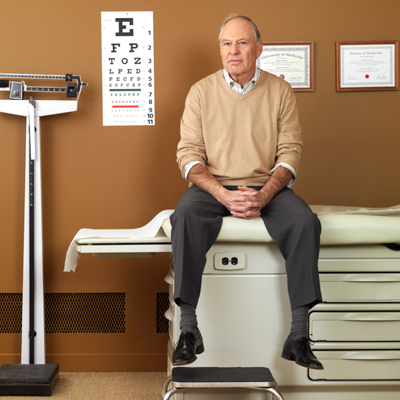Merely being a man can put you at greater risk for a wide range of health problems. This gender disparity in health occurs for an equally wide range of reasons. Men’s health risks can be greater than women’s in some areas because of lifestyle choices such as smoking, which men tend to do in greater numbers than women. Higher risks for men also stem from occupational exposures from male-dominated professions like construction work. Genetics, tied to the DNA coding for the male sex, plays a role, as do hormones, with experts often citing men’s lack of the protective benefits that women get from estrogen.
Here’s a look at 9 health conditions that affect men more often or more severely than women.
1. Color Blindness
Women can be color blind, but men are much more likely to be color blind than women. That’s because color blindness is determined by your genetic makeup — a gene passed from mother to child on the X chromosome. Because men have only one X chromosome, if they have the gene, they’ll have the condition. Women, on the other hand, have two X chromosomes so, if they have the gene on only one of them, they’ll become carriers of color blindness rather than having it themselves.
2. Fragile X Syndrome
Fragile X syndrome is the most common type of intellectual disability that is inherited in males. This genetic condition affects twice as many males as females, with about one in 4,000 males having Fragile X. It’s caused by a mutation in the gene FMR1 that is found on the X chromosome, and because men have only one X chromosome, they are more severely affected by this disorder than women. Symptoms of Fragile X can be noticeable in infancy or toddler-hood, and may include problems with intellectual development, delays in speech or language skills, behavioral difficulties, challenges with motor skills, and sensory issues. People with Fragile X also have characteristic physical features that become more apparent with age, including an elongated or narrow face, large forehead or ears, flat feet, large body size, and flexible joints.
3. Ankylosing Spondylitis
Men who have ankylosing spondylitis, a type of arthritis or inflammatory condition of the spine, have more severe symptoms than women, but experts don’t know why. However, some say this may spur men to seek a diagnosis for their pain, whereas women, whose symptoms are generally mild, may not even suspect that they have it. Ankylosing spondylitis appears to be linked to a gene known as HLA-B27. Two other chronic inflammatory conditions that affect more men than women are Behçet’s disease and Wegener’s granulomatosis.
4. Gout
Men also have gout, another type of arthritis or inflammatory disease, more frequently than women. Gender difference is a combination of hormones and lifestyle choices. Estrogen helps women more readily excrete the uric acid that contributes to gout. And, on the lifestyle side, men who want to avoid gout should consider cutting out foods and beverages that contain the chemical compound purine, such as various meats and beer, which lead to gout.
5. Heart Attack
More adult men than women die of heart attacks. Between ages 55 and 64, 185 of every 1,000 men die of a heart attack, compared with 95 per 1,000 women, according to data from the National Heart, Lung, and Blood Institute. A man’s risk is higher during most of his adult years, at least in part because of the lack of the protective benefit of estrogen.
6. Lung Cancer
Lung cancer is the leading cause of cancer death for both men and women; for every 100,000 adults, 60 men die from lung cancer each year, compared with 38 women. Quite simply, more men smoke and smoke more heavily.
7. Mesothelioma
A type of cancer that affects the lining and tissues of the chest and lungs, mesothelioma results from exposure to asbestos, a material once used in building insulation. Though mesothelioma is relatively uncommon, it tends to affect more men than women. Certain key professions that are associated with asbestos exposure, such as ship building and construction, tend to be male dominated.
8. Melanoma
Throughout adulthood, men are more likely than women to have melanoma, the most deadly form of skin cancer, and to die from it. In fact, according to the Skin Cancer Foundation, most people who are diagnosed with melanoma are white men older than 50 years of age. And men who are over the age of 40, in particular, are exposed to the highest levels of ultraviolet (UV) radiation (mainly sunlight) per year — the primary risk factor for skin cancer. The increased risk for melanoma among men could be due to lifestyle risk factors as well as the fact that men generally pay less attention to changes in their skin than women do.
9. Completed Suicide
More men than women are successful in their attempts to commit suicide each year. When men attempt suicide in the United States, they are more likely to use methods that are lethal, such as firearms, hanging, and carbon monoxide poisoning.
Bottom Line for Men’s Health
Despite the gender disparities in health borne out by the statistics, the most important takeaway for men is that you don’t have to give in to the statistics. In many cases, making healthy lifestyle choices and seeking medical attention early for new symptoms can help reduce the chance that you, personally, will be affected by these health problems or experience more severe effects.
Adapted via







